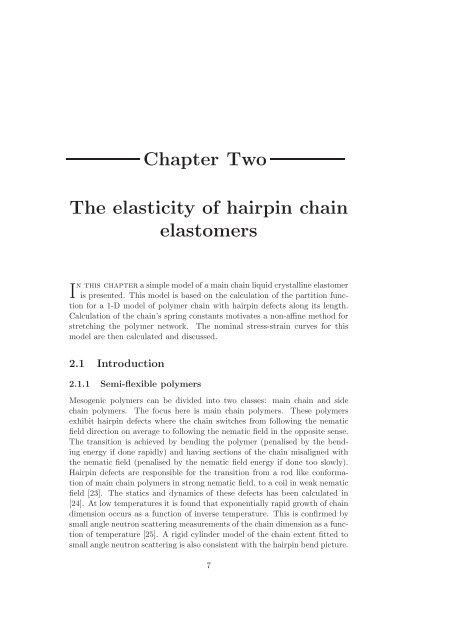Statistical models of elasticity in main chain and smectic liquid ...
Statistical models of elasticity in main chain and smectic liquid ...
Statistical models of elasticity in main chain and smectic liquid ...
Create successful ePaper yourself
Turn your PDF publications into a flip-book with our unique Google optimized e-Paper software.
Chapter TwoThe <strong>elasticity</strong> <strong>of</strong> hairp<strong>in</strong> cha<strong>in</strong>elastomersIn this chapterasimplemodel <strong>of</strong> a ma<strong>in</strong> cha<strong>in</strong> <strong>liquid</strong> crystall<strong>in</strong>e elastomeris presented. This model is based on the calculation <strong>of</strong> the partition functionfor a 1-D model <strong>of</strong> polymer cha<strong>in</strong> with hairp<strong>in</strong> defects along its length.Calculation <strong>of</strong> the cha<strong>in</strong>’s spr<strong>in</strong>g constants motivates a non-aff<strong>in</strong>e method forstretch<strong>in</strong>g the polymer network. The nom<strong>in</strong>al stress-stra<strong>in</strong> curves for thismodel are then calculated <strong>and</strong> discussed.2.1 Introduction2.1.1 Semi-flexible polymersMesogenic polymers can be divided <strong>in</strong>to two classes: ma<strong>in</strong> cha<strong>in</strong> <strong>and</strong> sidecha<strong>in</strong> polymers. The focus here is ma<strong>in</strong> cha<strong>in</strong> polymers. These polymersexhibit hairp<strong>in</strong> defects where the cha<strong>in</strong> switches from follow<strong>in</strong>g the nematicfield direction on average to follow<strong>in</strong>g the nematic field <strong>in</strong> the opposite sense.The transition is achieved by bend<strong>in</strong>g the polymer (penalised by the bend<strong>in</strong>genergy if done rapidly) <strong>and</strong> hav<strong>in</strong>g sections <strong>of</strong> the cha<strong>in</strong> misaligned withthe nematic field (penalised by the nematic field energy if done too slowly).Hairp<strong>in</strong> defects are responsible for the transition from a rod like conformation<strong>of</strong> ma<strong>in</strong> cha<strong>in</strong> polymers <strong>in</strong> strong nematic field, to a coil <strong>in</strong> weak nematicfield [23]. The statics <strong>and</strong> dynamics <strong>of</strong> these defects has been calculated <strong>in</strong>[24]. At low temperatures it is found that exponentially rapid growth <strong>of</strong> cha<strong>in</strong>dimension occurs as a function <strong>of</strong> <strong>in</strong>verse temperature. This is confirmed bysmall angle neutron scatter<strong>in</strong>g measurements <strong>of</strong> the cha<strong>in</strong> dimension as a function<strong>of</strong> temperature [25]. A rigid cyl<strong>in</strong>der model <strong>of</strong> the cha<strong>in</strong> extent fitted tosmall angle neutron scatter<strong>in</strong>g is also consistent with the hairp<strong>in</strong> bendpicture.7
















